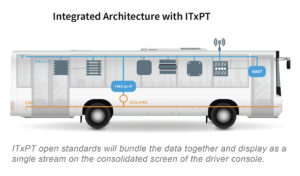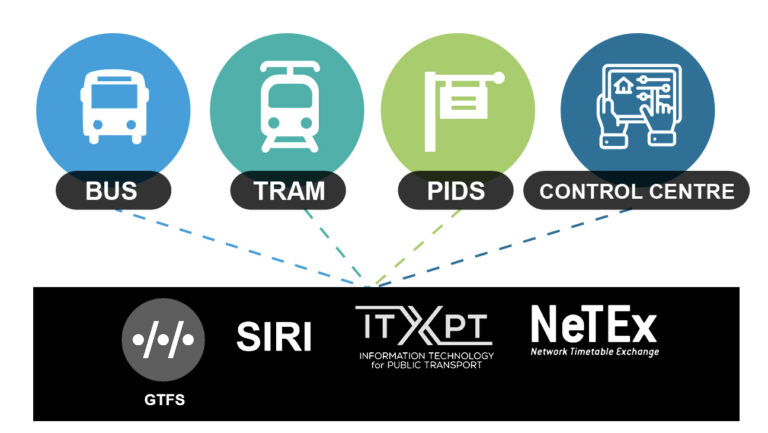Resource Hub
Why Adopting Open Standards in Public Transport Matters: Key Benefits Explained
For several years, the value of adopting open standards has been widely recognised in the public transport industry. These standards offer significant benefits in terms of interoperability, flexibility, and innovation. By using universally accepted, non-proprietary systems, cities are moving to ensure that different technologies and service providers can seamlessly integrate, improve efficiency, and reduce costs. Open standards also create an environment where competition can thrive, allowing for better service delivery, more affordable solutions, and faster adoption of new technologies.
Open standards help future-proof public transport systems, making them more adaptable to evolving needs, while ensuring operators and passengers benefit from a more connected, efficient, and sustainable transport network.
Sharing information and data is essential. However, integrating multiple devices and systems can be costly, particularly for the Intelligent Transport Systems (ITS) sector, where data sharing is required at the control centre level, on vehicles, such as buses and trams, and passenger information devices at stops and stations. The large number of systems used across this broad ecosystem makes compatibility with common standards a critical requirement.
Examples of open standards that have improved ITS interoperability include SIRI (Service Interface for Real-time Information), a standard developed in the early 2000s, GTFS (General Transit Feed Specification), NeTEx (Network Timetable Exchange), and more recently, ITxPT (Information Technology for Public Transport), a group of standards allowing for greater interoperability between equipment manufacturers and software providers.
There are also a range of German standards (published by the Verband Deutscher Verkehrsunternehmen (VDV – Association of German Transport Companies), which are widely used across Germany and around Europe. These standards enable greater flexibility, cost efficiency, and improved integration between different systems and vendors.
Some of the key benefits to Public Transport Authorities and Operators include:
-
- Cost Reduction: Eliminate dependence on proprietary solutions, lowering capital and operational expenses
-
- Flexibility & Scalability: Allow operators to integrate new technologies without being tied to a single supplier
-
- Improved Interoperability: Ensure seamless communication between different ITS components, enhancing overall efficiency
-
- Faster Deployment & Innovation: Reduce lead times for implementing new features or expanding services
-
- Enables Experimentation: Introduce and trial systems without bespoke development
Despite these considerable advances in ITS standards and capabilities, onboard vehicle technology interfaces have lagged and fallen behind many other areas, primarily due to:
-
- Slow serial-based interfaces with multiple variations and deviations from industry standards
-
- A lack of intellectual property (IP) standards interface between different technologies and software providers
-
- High costs and complexity associated with integrating multiple proprietary systems
-
- The need for multiple onboard computers and communication equipment to support different sensors and data sources
-
- Operators struggling to adopt new technologies without extensive modifications
Widening Industry Access with Open Standards
Public transport operators and authorities still face concerns about high costs and extended lead times, due to proprietary hardware and software solutions. There is also the significant risk of being locked into a single vendor, making future upgrades and integrations expensive and complex. There is also the risk of having to accept a lower level of functionality due to the as there will be dependence on older standards and interfacing.
ITxPT is an emerging set of open standards developed by through extensive collaboration between software providers, equipment manufacturers, and Transport Authorities and Operators. ITxPT standards focus on a service and data-centric approach to access, process, and manage onboard vehicle information. When in use, it enables:
- Seamless data access: Location data, passenger counts, passenger information, as well as context-rich data, including connection information where applicable
- Driver cab optimisation: ITxPT MADT (Multi Application Driver Terminal) specification enables multiple systems to display their information on one common command screen in the driver environment
- Vendor-neutral integration: Operators can purchase and deploy new technologies with minimal effort
- ITxPT Labelling: The ITxPT labelling and certification process provides is earned through rigorous testing of the that ensures maximum adherence implementation of to ITxPT standards. This Giving customers peace of mind that all integrations between systems or hardware that have ITxPT certification will be seamless
- Enhanced passenger experience: Real-time information and improved data sharing will contribute to better service quality
- Cost and operational efficiency: Reduce hardware duplication and streamline fleet management
By adopting ITxPT and similar standards, Public Transport Operators and Authorities can future-proof their systems, reduce vendor lock-in, enhance operational performance, and increase passenger satisfaction.
Many operators and agencies still rely on legacy systems that are deeply embedded in their operations. Replacing these systems will be costly and complex. Open standards’ main advantages are that they allow for a gradual transition from legacy systems to modern ITS solutions, reducing the risks and costs associated with complete system overhauls.
Trapeze has been a member of the ITxPT organisation since shortly after its establishment in 2016having previously played an active role in developing earlier standards such as CEN. Trapeze Group is now a Principal Member and is actively involved in ITxPT committees and working Groups, contributing to the ongoing development of these standards. Its involvement encompasses most development streams, and its active contribution as a supplier to the technical viability of specifications also helped address identified requirements.
Trapeze not only focuses on implementing ITxPT standards but also actively contributes feedback from real-world deployments and system integration experiences. This approach helps enhance compatibility across different vendors and drives the continuous evolution of the standards.
Real-World ITxPT Deployment
Trapeze deployed an ITxPT-compliant onboard solution for Société des Transports Abidjanais (SOTRA), the public transportation operator in Abidjan, Côte d’Ivoire. In this project, the certified solution is seamlessly integrated with third-party systems, including external and internal passenger displays, passenger counters, and ticket validators through ITxPT services.

An example of this integration is a single integrated log-on to the driver’s console, simplifying operations for the bus driver by providing a unified platform for managing interactions with all connected devices. The field experience from Trapeze provides valuable feedback to ITxPT, helping shape the evolution of these standards to ensure that best practices from operations are fed back into the ongoing development of open protocol best practices.
For example, in Singapore, Trapeze is working with Singapore’s Land Transport Authority (LTA) and using the ITxPT AVMS2 proposal to review the information that needs to be shared with other in-vehicle systems.
As ITxPT labelling is listed in more transport agency requirements, the need for equipment to be tested and verified as compatible becomes more important. Official ITxPT-labelled equipment achieves true compliance after rigorous testing and validation to ensure seamless interoperability. While compliance is based on key focus areas of specifications, some equipment may only support core elements that are required for its niche. Others may offer multiple services and data elements, a move that will result in ITxPT-labelled products.
To maintain the integrity of the standard, the ITxPT Laboratory independently:
-
- Validates compliance of products to ITxPT standards and the range of functionality
-
- Issues formal certification and labelling for fully compliant solutions
-
- Works with member companies when they enhance and modify products, ensuring they continue to meet certification requirements
For Transport Operators and Authorities, certified ITxPT products guarantee:
-
- Efficient integration across different systems and vendors
-
- Future-proofed solutions and services, with evolving open standards
-
- Reducing implementation risks and costs
By relying on officially labelled ITxPT solutions, the industry can ensure a truly interoperable and vendor neutral ITS ecosystem. This enables the public transportation sector to move towards a fully interoperable operational environment that will reduce costs, improve flexibility, and enable seamless integration of new technologies.

Open standards have been adopted at the control centre level since the early 1990s and continue to evolve. VDV developed some of the earliest widely adopted standards, including: VDV452, a standard focusing on sharing timetable and operational information between systems, and VDV300, a real-time passenger information exchange in vehicles. Some of the first standards were introduced in the late 1970s and early 1980s and, in the case of VDV300, there are just as many devices that have been deployed. This also includes the custom implementation of messages. Major German cities, such as Berlin and Hamburg, as well as Zurich in Switzerland, were among the early adopters of these VDV standard and deployed it in their respective ITS systems.
The table below depicts a summary of the different open standards used across the public transport space in 2025:
| Operational/Management Functions | Open Standards for Public Transport |
|---|---|
| Planning Systems which generate the timetable, duty rosters and vehicle block information | VDV452 TransXchange (a standard initially defined in the UK for regulatory purposes) NetEx GTFS though some extensions may be needed |
| Real-Time information to external systems, roadside signs, web sites and mobile applications | SIRI standards, with different variants, • SIRI SM for providing specific stop information, • SIRI VM for tracking vehicle locations, • SIRI CM for connection information • SIRI ET for estimated timetable information GTFS-RT for real time GTFS |
| In Vehicle Interfaces for destination, next stop, in vehicle signs, passenger counters and many other devices. | ITxPT Services including AVMS ITxPT MQTT topics in AVMS2 VDV301 alternative Services similar to ITxPT Serial Interface VDV300 |
| Historical and Reporting Information for performance reporting | OpRa building on Transmodel framework for reporting |
Trapeze supports these open standards across its extensive ITS solutions. The data supply systems can import data in many different formats, from the relatively simple GTFS, to the richer VDV452, NetEx, and TransXchange formats. This multi-standard support ensures there are options to consider when developing a robust management system to meet the operational requirements. With this robust capability, real-time solutions can be deployed across various customer environments and interface with existing planning systems.
Notably, the open approach to data supply was adopted in Singapore when the fleet management system was deployed into their franchised bus operations. This enabled Singapore’s bus operators to procure planning systems from a range of suppliers, rather than be restricted to a specific tool.
For Singapore’s LTA, Trapeze is providing an ITxPT compliant MADT unit for the driver display as part of the upcoming system enhancement exercise. This enables multiple applications to be present on one display with the driver switching tabs between information screens, similar to how a multi-tab browser operates, to access multiple connected systems. Initially, this will support the Trapeze fleet management system and the LTA ticketing contractor that connects to the same driver terminal.
Consolidating multiple displays into one screen ensures everything can be displayed seamlessly and easily. This creates a less cluttered space in the cab environment and provides the display with multiple ergonomic positions that directly cater towards the comfort level and needs of the driver.
Another example had to do with how Trapeze played a role to implement a traffic signal priority system across London. For this project, Trapeze worked with the Transport for London (TfL) authority to review the available standards and integrate them with specific requirements for London, while not compromising on operational compatibility. This enabled other buses, from the surrounding areas, to potentially access traffic signal priority across the capital.
Across the world many millions of travellers are receiving real-time updates from our systems to their mobile devices where the underlying solution is driven through the use of open data that run on SIRI or GTFS-R protocols, as well as specific open data distribution initiatives. Using standards, supporting the development of standards, and providing the data feeds as part of core systems, all of that enabled Trapeze to work with Public Transport Operators and Authorities to concentrate on delivering its core solution, the real-time transport management system, and enable other companies and organisations to develop their specific distribution channels that cater to their pool of users and customers.
Trapeze is also committed to innovation and actively contributes to the development of new standards. For example, in collaboration with its various customers, it is currently implementing an initial prototype of the ITxPT AVMS2 data-centric service. This initiative not only drives project-specific advancements, but also provides valuable practical insights, allowing users to contribute feedback to help shape and refine the standard.
Driving Forward with Open Standards
odern public transport management systems are becoming increasingly sophisticated and connected, primarily facilitated by the adoption of open standards. The adoption of these standards among Public Transport Authorities, bus operators and their suppliers, provides an environment for efficient and effective extensions to existing systems.
It also empowers Public Transport Authorities and Operators with the ability to procure elements of other solutions independently on the open market.
As Trapeze software and systems support a wide range of open standards, they will empower customers to choose from a wide range of systems with open interfaces available to support integration. As it is open to different data supply providers, operational management systems, depot and electric charging systems, and real-time passenger information solutions with support for a wide range of in-vehicle peripherals, this robust platform can seamlessly integrate with these standards and continue to drive forward next-generation innovations for this space.
To learn more about how Trapeze Group can support your ITS project through technology based on Open Standards, read our ITS evaluation guide, contact us or visit our website to read more content on this topic.
Blog
Beyond the Horizon- How to stay relevant when selecting AVLC systems
Uncover the importance of understanding ITS and navigating AVLC specifications for making informed decision when selecting AVLC systems.
Mode of Transport
Public Transport Authorities, Bus
Solutions
Intelligent Transport Systems
